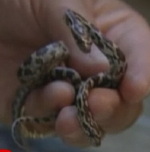Category:
Animals
Animals
Pavlovian Fish
Ivan Pavlov famously conditioned dogs to salivate every time they heard a dinner bell. The U.S. Army hopes to use a similar technique to train fish in Buzzards Bay off the coast of Massachusetts. According to the Cape Cod Times, the experiment:houses 5,000 juvenile black sea bass in a dome-shaped structure at the bottom of Buzzards Bay, for the purpose of feeding them after playing a 280 Hz tone. The study is being led by Scott Lindell, director of MBL's Scientific Aquaculture Program, to determine whether the caged fish — once accustomed to the tone then released into the wild — will return to the dome for recapture when the tone is played. The hope is to create a less harmful way to fish or better replenish natural fish stock, project officials told the Times in March.
The experiment has raised concerns among a consumer advocacy group, who are suing the Army, but that's not what interests me. What interests me is whether the fish salivate when they hear the tone. Do fish, in fact, have salivary glands? An answer from genuineideas.com:
Although the most well developed glands are found in mammals, many other vertebrates and invertebrates have salivary glands. Fish and other aquatic animals clearly do not lack opportunities to add water to their meals; hence most aquatic animals are devoid of "true" salivary glands. However, some form of lubrication is still necessary to assist swallowing even in water, and this is provided by mucous glands along the tongue and roof of mouth (Mucous secretion is present in all animals.)
And that's your weird fish fact of the day.
Posted By: Alex - Sun Jul 13, 2008 -
Comments (1)
Category: Animals, Experiments
Two-Headed Snake

We'll have to not let them see each other when they're feeding because if they do they will devour the other snake. So if one snake has a mouse in its mouth and the other one sees it, it will try to get the mouse as well and try to devour it and therefore take in the whole other snake.
Apparently they're going to call them Bush and Rove.
(Thanks to Big Gary for the link and the joke.)
Posted By: Alex - Fri Jul 11, 2008 -
Comments (0)
Category: Animals
Plastic Pink Flamingo Shortage imminent!
Crude oil heading toward $200.00 a barrel? Trivial! More important here at WU Central is the upcoming dearth of avian lawn ornaments as the company that makes them goes bankrupt!
Read the whole sad story here.
How will extortionate charities get their money now, if the practice of "flamingoing" is doomed?
Posted By: Paul - Thu Jul 10, 2008 -
Comments (10)
Category: Animals, Business, Products, Customs, Domestic, Inventions

| Who We Are |
|---|
| Alex Boese Alex is the creator and curator of the Museum of Hoaxes. He's also the author of various weird, non-fiction, science-themed books such as Elephants on Acid and Psychedelic Apes. Paul Di Filippo Paul has been paid to put weird ideas into fictional form for over thirty years, in his career as a noted science fiction writer. He has recently begun blogging on many curious topics with three fellow writers at The Inferior 4+1. Contact Us |




